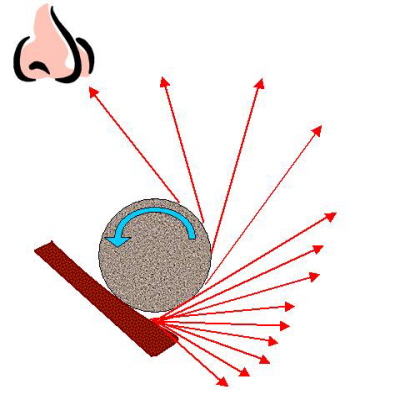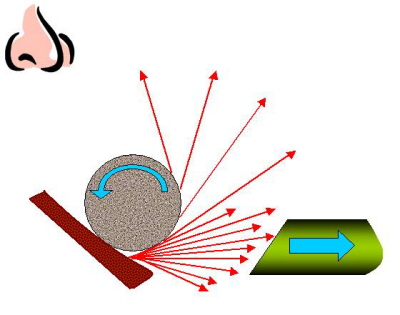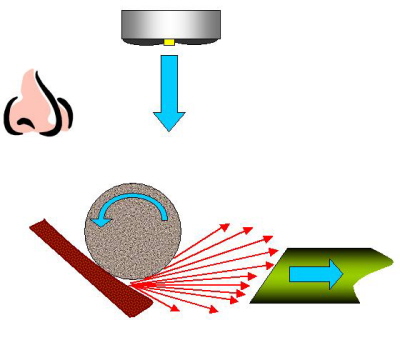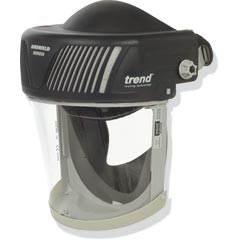| LaymarCrafts
Woodturning |
Information |
| Dust, everyone's Problem.
We all have to put up with perhaps the
most damaging bi-product of making things on the Woodturning Lathe,
Dust, but we can do things to make life in the Workshop a little bit
Healthier and therefore benefit our well being. |
 |
In the Hints & Tips Section of
this Web Site I describe a Dust Collection System I have made and here I try and
analyse its effectiveness and also highlight what I think are the key areas and
situations that determine what is the best way to trap and collect the Dust
generated during Turning and Sanding.
Firstly the anatomy of Woodturning
is different to an other major Dust Generator in the Workshop in as much as the
Workpiece, i.e. the Wood is in motion whereas with all other Woodworking
Machines the the Wood is, in principle, Static and it is the Machine Cutter that
rotates.
Also we have a situation where the
Workpiece on a Lathe is open on all sides, there is no natural catchment
chamber to which you can connect a Vacuum Extractor System as there is with most
other Machines.
So what is our Objective? Primarily
it has to be to protect ourselves from the Inhalation of Dust, if this is the
case then surely a suitable Respirator is all we need, it must therefore also be
for other reasons? in my case it is to have a near Dust Free Working Environment
as possible.
I will also admit that I will
often work at the Lathe without my Respirator in place, I know this is not good practice,
but!!!, so therefore the best Dust Control I can achieve is desirable.
If we look at the things that are relevant
and therefore perhaps understand why the Dust goes everywhere we do not want it
to go we can perhaps better understand what our problem is.
Dust will dissipate through out
any Workshop as a result of:
Airborne Dust carried in Air
Currents whether Mechanically Generated i.e. with a Fan, or Thermally Generated due
to the Draft that will be created by virtue of the fact that Hot Air rises and
Cold Air falls i.e. Thermal Currents.
Dust from the Wood being Turned
will be spread due to entrapment within the Shavings, Projection from the Tool,
typically along the Flute of a Gouge and by Centrifugal Force directly off of
the Spinning Wood.
Dust as a result of Sanding will
follow a typical pattern which is
primarily created by Centrifugal Force and as a result of the Coanda Effect.
And finally as we move around the
Workshop or whenever we Dust ourselves down we disturb and spread some Dust.
In the illustration [Fig.1] below I show a
typical situation that can be readily observed when Sanding, [ this is best done
whilst someone else does the sanding and you do the observing], which is perhaps
the biggest single process for the production of Dust, in this illustration there is no Dust
Extractor or Fan System in use this is just Sanding in natural conditions.
 Fig.1
Fig.1
The actual projection and
dissipation of the Dust will be dependent on many factors:-
-
Speed of the Lathe.
-
Diameter of the Piece.
-
Combined these two points
above will give a "Tip Speed" at the point of contact.
-
The Angle at which you apply
the Abrasive, I tend to use the Abrasive at 8 O'clock.
-
The Grit Size of the Abrasive
which will determine the Dust Particle Size.
-
The Pressure at which the
Abrasive is applied.
-
The Density of the Wood due to
its type, e.g. Oak has a higher density than Pine.
-
The Density of the Dust
Particle due to the Wood Type and Grit Size of Abrasive.
-
Other factors that will play a
part are, Humidity, Position of Lathe relative to other surfaces etc.
As you can see there are 8 or 9
significant factors that you may have to consider if you are going to successfully
Trap and Collect the Dust, which will disperse differently as anyone of the
above changes.
In my case I can create a situation
where the Dust will eject itself, into the surrounding space, with a wrap around
of up to 2/3rds of
the circumference of a Piece, this however can be controlled, to a degree, by
Sanding with not too much pressure and at low speed, but such a combination is not always
convenient or practical.
So what can we do? I like many purchased a
Shavings/Dust Collector , the selection of which was based on it's Price rather than any
knowledge of what it was really capable of, and the Sales Guy at the Store assured me
it was OK for a Lathe? I now know otherwise.
Here [Fig.2] I illustrate my
observations with only the Dust Extractor System On, using my original Unit, as detailed in
the Hints & Tips Section, which offers a more controlled Collector Nozzle
than just the Flexible Hose that I was provided with the Unit.
 Fig.2
Fig.2
You will see that the Dust
Extractor has an influence on the Projection of the Dust with perhaps a maximum
wrap of no more than half way around the Piece which is an improvement but it
can be improved on.
Making the Nozzle larger is not necessarily
the solution as you are relying on the Air Intake Velocity to draw the Dust in
and by increasing the cross sectional area of the Nozzle you will reduce the
Velocity and therefore pick up less Dust, although you may well catch slightly
more of the Dust by virtue of the position of the larger Nozzle? it is a
compromise situation.
In Fig.3 I show the results I have
obtained from using the Low Level Dust Extractor Box and the Down Draft Fans
above the Lathe, again see the Hints & Tips Section, this is giving me a far better
Dust Catchment and although it could probably be improved by adding a more
Powerful Dust Extractor and Downdraft Fans there would have to be a compromise
with respect to Comfort and Noise.
 Fig.3
Fig.3
The principle here is that as used in
Air Curtains, typically as utilised in Clean Rooms, where the Air Curtain contains or limits the
passage of a substance, in our case Dust, and forces it to change direction
[downwards] to
be picked up by the Dust Extractor.
If you can imagine the Fan in
Fig.3 having a reversed Air Flow, as you may have with one of the Dust Filter
Units, then it is obvious that a large portion of the Dust will be directed
upward and away from the Extractor Nozzle and therefore in direct conflict with
what you are actually attempting to do.
I feel I have a good balance with
my system and
would like to be able to quantify just how efficient it is, I was thinking of
carrying out a series of tests based on the three scenarios above by measuring, probably by Weight, the amount of Dust deposited in and around the Workshop and
the amount actually in the Dust Collection Bag of the Extractor.
This would be a worthwhile
exercise, but I am not sure I have the time and the discipline to do such a study, perhaps a Student looking for a Final Year Project might take
up the challenge.
|
LaymarCrafts Woodturning is the Web
Site of Richard & Sheila Stapley
All Content, Articles, Pictures & Diagrams as Presented are the ©
Copyright of LaymarCrafts & Richard Stapley
Last update 06 January 2009
All Rights Reserved |
|
Web Site Design & Construction by
Richard Stapley. |

